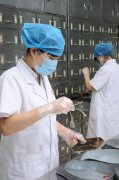Humifuse euphorbia herb
Annual herb, 10-15cm high, containing white latex; root slim, usually not branched; stem slim, generally hairless, crawling, generally branched from basal part, purplish red. Simple leaf opposite, elliptic, 5-10mm long, 4-6mm wide, apex blunt and round, basal part oblique, slightly narrow, margin usually with thin saw like teeth above the middle part, green or sometimes purplish red, hairless or slightly covered with hairs. Petiole extremely short; stipule linear, generally with 3 deep lobes. Cyathium, solitary in leaf axil or the apex of lateral branches; periclinium invert conical, light red, with 4 lobes, lobe long triangular, with 4glands where curved, transversely long circular, with white petal like attachments; male flower with only 1 stamen, filament short, without perianth; female flower solitary at the centre of inflorescence, gynophore extending out of the periclinium, ovary with 3 ventricles, ovary superior, style 3, separated, stigma with 2 lobes. Capsule consisting of 3 bivalved mericarps, 3 angled ovate spherical, smooth and hairless, style persistent. Seeds egg shaped, blackish brown, exterior covered with white pollens, each ridge surface without transverse groove, about 1.2mm long, about 0.7mm wide.
Flowering: June to October;
Fruiting: July to October.
Distribution Growing on plains, deserted fields, paddy edges and roadsides. Distributed in all parts of China. Produced in most parts of China.
Chemistry Mainly contains flavonoid, tannin and triterpene, quercitin glycoside and kaempferide glycoside, pyrogallic acid and pyrocateehol, etc. Also contains alkaloids and volatile oils.
Pharmacology Anti-bacterial, antiparasitic, detoxifying and hemorrhage-relieving.
Properties & Actions Pungent, neutral. Clearing heat-toxin, cooling blood and relieving hemorrhage.
Examples 1. Blood and white dysentery: collect humifuse spurge, wash, dry under the sun, grind into powder, and swallow 1 qian with rice water.
Examples 2. Treat tooth hemorrhage: fresh humifuse spurge, wash clean, decoct and gargle.
Examples3. Bacterial dysentery cure: fresh euphorbia humifusa 30 grams, 30 grams of radix paeoniae alba, 30 grams of fresh purslane. Water decoction, daily 1 agent, morning and evening.
Examples 4. Treat gastroenteritis: fresh euphorbia humifusa 30 grams, rhizoma atractylodis 10 grams, 10 grams atractylodes, radix paeoniae alba 10 grams, licorice root 6 grams. Water decoction, daily 1 agent, morning and evening.
Examples 5. A cold cough: fresh euphorbia humifusa 30 grams, 30 grams of flos lonicerae, fructus forsythiae 10 grams, 10 grams, platycodon almond 10 grams, liquorice 10 grams. Water decoction, daily 1 agent, morning and evening.
Examples 6. To treat dysfunctional uterine bleeding: humifuse euphorbia herb 30 grams, 15 grams of field thistle, crane grass 10 grams, cortex moutan 10 grams, cogongrass rhizome 15 g. Water decoction, daily 1 agent, morning and evening.




评论
发表评论